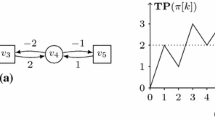Abstract
In the Spy game played on a graph G, a single spy travels the vertices of G at speed s, while multiple slow guards strive to have, at all times, one of them within distance d of that spy. In order to determine the smallest number of guards necessary for this task, we analyze the game through a Linear Programming formulation and the fractional strategies it yields for the guards. We then show the equivalence of fractional and integral strategies in trees. This allows us to design a polynomial-time algorithm for computing an optimal strategy in this class of graphs. Using duality in Linear Programming, we also provide non-trivial bounds on the fractional guard-number of grids and tori, which gives a lower bound for the integral guard-number in these graphs. We believe that the approach using fractional relaxation and Linear Programming is promising to obtain new results in the field of combinatorial games.


Similar content being viewed by others
Notes
For any graph G, any integer \(\ell \) and \(v\in V(G)\), let \(N_{\ell }[v]\) be the set of vertices at distance at most \(\ell \) from v in G and let \(N[v]=N_1[v]\).
Indeed, \(O((n/d)^2)\) vertices are sufficient to dominate every vertex at distance d in \(G_{n \times n}\) (tiling the grid with vertex-disjoint balls of radius d).
In strategy \(P_{2r_1}\), that guard must be at distance \(\le d\) from \((2r_1,2j_1)\) when the spy visits it.
Similarly, for strategy \(P_{2r_2}\).
Solving the LP for \(n\ge 150\) takes more than one hour on a basic laptop.
References
Aigner, M., Fromme, M.: A game of cops and robbers. Discrete Appl. Math. 8, 1–12 (1984)
Balister, P., Shaw, A., Bollobás, B., Narayanan, B.P.: Catching a fast robber on the grid. JCTA 152, 341–352 (2017)
Beaton, I., Finbow, S., MacDonald, J.A.: Eternal domination numbers of \(4\times n\) grid graphs. J. Comb. Math. Comb. Comput. 85, 33–48 (2013)
Bonato, A., Chiniforooshan, E., Pralat, P.: Cops and robbers from a distance. Theor. Comput. Sci. 411(43), 3834–3844 (2010)
Bonato, A., Nowakowski, R.J.: The Game of Cops and Robbers on Graphs. American Mathematical Society, Providence (2011)
Bondy, J.A., Murty, U.S.R.: Graph Theory, Graduate Texts in Mathematics, vol. 244. Springer, Berlin (2008)
Burger, A., Cockayne, E.J., Gründlingh, W.R., Mynhardt, C.M., van Vuuren, J.H., Winterbach, W.: Infinite order domination in graphs. J. Comb. Math. Comb. Comput. 50, 179–194 (2004)
Cohen, N., Hilaire, M., Martins, N.A., Nisse, N., Pérennes, S.: Spy-game on graphs. In: 8th International Conference on Fun with Algorithms, FUN 2016, pp. 10:1–10:16 (2016)
Cohen, N., Mc Inerney, F., Nisse, N., Pérennes, S.: Study of a combinatorial game in graphs through linear programming. In: 28th International Symposium on Algorithms and Computation (ISAAC 2017), LIPIcs 92, Schloss Dagstuhl, pp. 22:1–22:13 (2017). https://hal.archives-ouvertes.fr/hal-01462890
Cohen, N., Martins, N.A., Mc Inerney, F., Nisse, N., Pérennes, S., Sampaio, R.: Spy-game on graphs: complexity and simple topologies. Theor. Comput. Sci. 725, 1–15 (2018). https://hal.archives-ouvertes.fr/hal-01782246v1
Delaney, A.Z., Messinger, M.E.: Closing the gap: Eternal domination on \(3\times n\) grids. Contrib. Discrete Math. (2015)
Fomin, F.V., Giroire, F., Jean-Marie, A., Mazauric, D., Nisse, N.: To satisfy impatient web surfers is hard. In: 6th International Conference on Fun with Algorithms (FUN), LNCS, vol. 7288, pp. 166–176 (2012)
Fomin, F.V., Golovach, P.A., Kratochvíl, J., Nisse, N., Suchan, K.: Pursuing a fast robber on a graph. Theor. Comput. Sci. 411(7–9), 1167–1181 (2010)
Giroire, F., Mazauric, D., Nisse, N., Pérennes, S., Soares, R.P.: Connected surveillance game. In: Moscibroda, T., Rescigno, A.A. (eds.) 20th International Colloquium on Structural Information and Communication Complexity (SIROCCO). Lecture Notes in Computer Science. Springer, Berlin (2013)
Giroire, F., Nisse, N., Pérennes, S., Soares, R.P.: Fractional combinatorial games. Technical report, INRIA, (2013). RR8371. http://hal.inria.fr/hal-00865345
Goddard, W., Hedetniemi, S.M., Hedetniemi, S.T.: Eternal security in graphs. J. Comb. Math. Comb. Comput. 52, 160–180 (2005)
Gonçalves, D., Pinlou, A., Rao, M., Thomassé, S.: The domination number of grids. SIAM J. Discrete Math. 25(3), 1443–1453 (2011)
Joret, G., Kaminski, M., Theis, D.O.: The cops and robber game on graphs with forbidden (induced) subgraphs. Contrib. Discrete Math. 5(2), 40–51 (2010)
Kinnersley, W.B.: Cops and robbers is exptime-complete. JCTB 111, 201–220 (2015)
Klostermeyer, W.F., MacGillivray, G.: Eternal dominating sets in graphs. J. Comb. Math. Comb. Comput. 68, 97–111 (2009)
Kosowski, A., Li, B., Nisse, N., Suchan, K.: k-Chordal graphs: from cops and robber to compact routing via treewidth. Algorithmica 72(3), 758–777 (2015)
Kusters, R.: Memoryless determinacy of parity games. In: Automata, Logics, and Infinite Games: A Guide to Current Research, LNCS, vol. 2500, pp. 95–106 (2002)
Lamprou, I., Martin, R., Schewe, S.: Perpetually dominating large grids. In: 10th International Conference on Algorithms and Complexity (CIAC 2017), LNCS, vol. 10236, pp. 393–404 (2017)
Nowakowski, R.J., Winkler, P.: Vertex-to-vertex pursuit in a graph. Discrete Math. 43, 235–239 (1983)
Quilliot, A.: Problèmes de jeux, de point fixe, de connectivité et de représentation sur des graphes, des ensembles ordonnés et des hypergraphes. Doctorat d’état, Univ. Paris 4 (1983)
Schröder, B.S.W.: The copnumber of a graph is bounded by \(\lfloor \frac{3}{2} genus (g) \rfloor + 3\). In: Koslowski, J., Melton, A. (eds.) Categorical Perspectives (Kent, OH, 1998). Trends in Mathematics, pp. 243–263. Birkhäuser, Boston (2001)
Scott, A., Sudakov, B.: A bound for the cops and robbers problem. SIAM J. Discrete Math. 25(3), 1438–1442 (2011)
van Bommel, C.M., van Bommel, M.F.: Eternal domination numbers of \(5\times n\) grid graphs. J. Comb. Math. Comb. Comput. 97, 83–102 (2016)
Author information
Authors and Affiliations
Corresponding author
Additional information
Publisher's Note
Springer Nature remains neutral with regard to jurisdictional claims in published maps and institutional affiliations.
This work has been partially supported by ANR project Stint under reference ANR-13-BS02-0007, ANR program “Investments for the Future” under reference ANR-11- LABX-0031-01, the associated Inria team AlDyNet. Extended abstracts of parts of this paper have been presented in [8] (Sect. 5.1) and [9].
Rights and permissions
About this article
Cite this article
Cohen, N., Mc Inerney, F., Nisse, N. et al. Study of a Combinatorial Game in Graphs Through Linear Programming. Algorithmica 82, 212–244 (2020). https://doi.org/10.1007/s00453-018-0503-9
Received:
Accepted:
Published:
Issue Date:
DOI: https://doi.org/10.1007/s00453-018-0503-9




